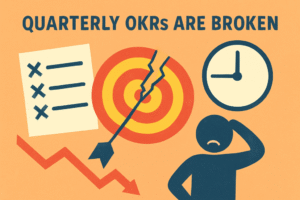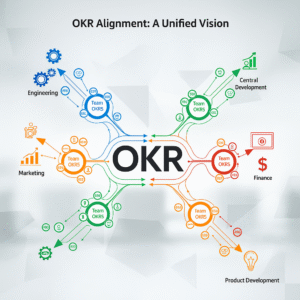In many organizations, there’s a silent killer of productivity and outcomes lurking just beneath the surface. It doesn’t make headlines, but it wreaks havoc on teams, delays strategic goals, and drains energy from the people doing the work. It’s the problem of having too much work in progress (WIP).
If you’re leading teams, driving strategic change, or simply trying to keep your head above water in a sea of competing priorities, you may already be feeling the symptoms. But before we dive into how to fix it, let’s first understand the root causes and the telltale signs that your organization is struggling with too much WIP.
The Root Causes of Too Much Work in Progress
1. Lack of Initiative Portfolio Management
One of the biggest reasons organizations get overwhelmed with WIP is the absence of a structured approach to initiative portfolio management. Without a clear way to assess, balance, and govern the work being taken on, new projects and initiatives get added indiscriminately. Leaders say “yes” to new work before understanding the impact on existing commitments, leading to a bloated portfolio where nothing moves efficiently.
A well-managed initiative portfolio ensures that resources, capacity, and strategic priorities are aligned. When that discipline is missing, every new project feels like an urgent priority—until progress stalls across the board.
2. Poor Portfolio Prioritization Frameworks
Even when organizations have some form of initiative tracking, they often lack a robust portfolio prioritization framework. Instead of prioritizing based on strategic impact, value, and capacity, decisions get made based on who is shouting the loudest, reacting to the latest crisis, or political considerations.
This results in multiple initiatives competing for the same resources, with teams switching contexts frequently, leading to slow progress and burnout. Without a clear prioritization mechanism, work gets added faster than it gets completed, exacerbating the WIP problem.
3. Overcommitment Driven by Leadership or Culture
Many organizations operate in a culture where saying “no” is frowned upon. Leaders want to demonstrate progress on multiple fronts, executives want quick wins, and teams feel pressure to commit to unrealistic workloads. This results in a state where managing multiple initiatives becomes chaotic rather than strategic.
A department with several teams became concerned with a lengthening delivery timeline. The teams regularly received requests for useful features, which were immediately placed in the backlog—which was growing at an alarming rate. The teams did not feel they could say no, and the Product Owner was not actively managing the requests. The team lead started plotting the backlog additions against completed features. It became obvious that the project would never end unless someone began saying no to features that were not really needed.
This over-commitment leads to a deceptive sense of busyness—everyone is working hard, but little is actually getting delivered. The hidden cost? Increased time to market, decreased quality, and a general feeling of never making meaningful progress.
4. Misalignment Between Capacity and Demand
Even in organizations that track workload and capacity, there’s often a disconnect between demand (new initiatives, urgent projects) and supply (available time, skilled people). This happens when capacity planning is treated as an afterthought rather than a key input into decision-making.
When demand consistently exceeds capacity, teams end up juggling multiple initiatives without making meaningful progress on any of them. This creates a situation where the “invisible work” (switching, waiting, rework) outweighs actual productive work.
5. Lack of Visibility into Work in Progress
Many organizations don’t have a clear picture of everything currently in flight. Without strong visualization—whether through a work-in-progress board, dashboards, or structured reporting—teams and leaders operate in the dark.
The result? Everyone feels like they’re making the best decisions in the moment, but in reality, new work is constantly added without fully understanding what’s already consuming capacity.
In one small company with a limited development team, the management was frustrated that the team would take so long (many months) to complete even a simple feature request. Tension mounted. After tracking and visualizing what the team was working on, it was discovered that just over 50% of their effort was being spent responding to last-minute requests. Even the best of teams would have taken twice as long as usual to finish a feature! Management took note and actively reduced interfering requests.
How to Identify If You Have a WIP Problem
Recognizing that your organization is suffering from too much WIP is the first step toward solving it. Here are some warning signs that indicate trouble:
1. Everything Is in Progress, But Nothing Is Getting Finished
This is the most obvious red flag. If you have a long list of initiatives, projects, or tasks that seem to be in a perpetual state of “in progress” without hitting completion, you likely have too much WIP.
2. Constant Context Switching and Burnout
When teams are spread too thin across multiple initiatives, they spend more time switching between tasks than actually doing deep, productive work. This leads to delays, frustration, and eventually burnout. If your teams complain about being overwhelmed but you’re not seeing corresponding delivery, excessive WIP is likely the cause.
3. Frequent Firefighting and Unplanned Work
Another indicator of excessive WIP is the presence of frequent emergency work. When teams are overloaded, they have less flexibility to handle surprises. As a result, unexpected issues throw everything into chaos, pushing important (but not urgent) work further down the priority list.
4. Bottlenecks Everywhere
If certain teams or functions (e.g., security, compliance, engineering) are constantly causing delays because they’re overwhelmed, it may not be their fault. The real issue might be that too many initiatives are in flight at the same time, all requiring the same limited resources.
5. Increased Cycle Time and Missed Deadlines
Are projects or features taking much longer to complete than expected? Do your teams keep missing deadlines despite putting in more effort? They could be trying to work on too much at once. Trying to do everything is leading to inadequate progress.
6. Lack of Strategic Progress
If your organization is constantly busy but not making significant strides toward its strategic goals, you have a prioritization problem. When you have too much work in progress, it becomes harder to prioritize. This leads to work happening, but it’s not necessarily the right work moving forward. This often stems from poor initiative portfolio management and an ineffective portfolio prioritization framework.
7. Leadership Frustration Over Slow Results
If executives and senior leaders are constantly asking, “Why is this taking so long?” or “Why aren’t we seeing more results?” it’s worth investigating whether the issue is too much WIP. In many cases, the teams are working hard—but their efforts are spread so thin that meaningful progress is slow across all fronts.
Conclusion
Excessive work in progress is one of the most common but least acknowledged barriers to organizational effectiveness. Without proper initiative portfolio management and a clear portfolio prioritization framework, organizations find themselves juggling too many competing priorities with diminishing returns.
The first step toward fixing the issue is recognizing it. If you’re seeing signs like stalled progress, overwhelmed teams, constant firefighting, and frustrated leadership, it’s time to take a hard look at how work is being managed.
In a future post, we’ll explore strategies to address these issues, reduce WIP, optimize prioritization, and create a healthier, more effective flow of work. But for now, ask yourself: How much WIP is too much in your organization?




